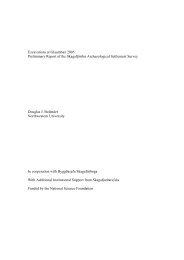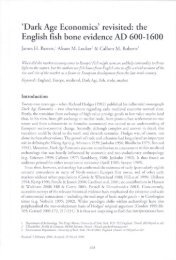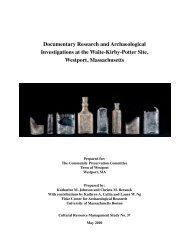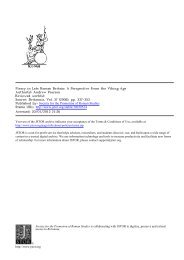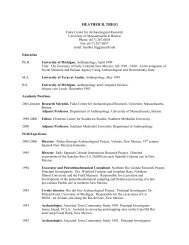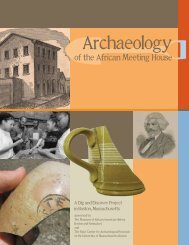archaeological site examination north yard of the ... - Fiske Center
archaeological site examination north yard of the ... - Fiske Center
archaeological site examination north yard of the ... - Fiske Center
Create successful ePaper yourself
Turn your PDF publications into a flip-book with our unique Google optimized e-Paper software.
creamware, pearlware, redware, transfer<br />
printed whiteware, wine bottle glass, window<br />
glass, brick and cut and wrought nails.<br />
The B-horizon consisted <strong>of</strong> a yellow brown<br />
silty clay loam and only <strong>the</strong> upper 3 to 4<br />
cm contained cultural material, all <strong>of</strong> which<br />
is firmly associated with <strong>the</strong> eighteenth century.<br />
This included fragments <strong>of</strong> a white<br />
salt glazed stoneware plate (1740-1775),<br />
regular and deeper yellow creamware<br />
(1762-1780), a possible redware planting<br />
pot, window glass and nails. Three clay<br />
tobacco pipe stems and an oyster shell were<br />
also present.<br />
2. Irregular Planting Bed adjacent to<br />
Greenough Avenue<br />
Figure V-6: East wall pr<strong>of</strong>ile <strong>of</strong> Unit 5 in<br />
<strong>the</strong> Irregular Planting Bed.<br />
The Irregular Planting Bed that lies adjacent<br />
to Greenough Avenue was tested with<br />
a single 1 m x 1 m unit (EU 5) that was<br />
located on <strong>the</strong> bed’s south border (see Fig.<br />
V-2). The <strong>north</strong>west half <strong>of</strong> <strong>the</strong> unit lay<br />
within <strong>the</strong> bed, while its sou<strong>the</strong>ast half<br />
extended beyond <strong>the</strong> bed boundary. The<br />
unit was oriented cardinally, 12 m south <strong>of</strong><br />
<strong>the</strong> <strong>north</strong> property fence line and 17.30 m<br />
west <strong>of</strong> <strong>the</strong> east fence line. The uppermost<br />
A 1 -horizon consisted <strong>of</strong> a dark brown fine<br />
sandy loam that was present both within<br />
and outside <strong>of</strong> <strong>the</strong> bed. This layer was 20<br />
cm thick within <strong>the</strong> bed, and slightly thinner<br />
in <strong>the</strong> <strong>yard</strong> (Fig. V-6). Cultural material<br />
from this layer included modern bottle glass<br />
and tarpaper as well as a few small fragments<br />
<strong>of</strong> wine bottle glass, redware, pearlware,<br />
whiteware ceramics and cut nails. A<br />
sudden increase in gravel marked <strong>the</strong> lower<br />
A 2 -horizon that consisted <strong>of</strong> a dark medium-brown<br />
sandy clay loam. This layer<br />
extended to a depth <strong>of</strong> approximately 40<br />
cmbs and contained a similar assortment <strong>of</strong><br />
fragmented artifacts including coal slag and<br />
calcined bone fragments. The surface <strong>of</strong><br />
<strong>the</strong> underlying B-horizon was poorly<br />
defined and consisted <strong>of</strong> a yellow-brown<br />
medium sandy clay loam with coarse sand<br />
and gravel. Artifacts here were similar to<br />
those above with bottle glass, brick and<br />
mortar fragments, calcined bone and ceramics<br />
that included whiteware, yellow ware<br />
and ironstone (1842-1930) fragments. A<br />
single small, rounded feature was identified<br />
in <strong>the</strong> southwest corner just below <strong>the</strong> surface<br />
<strong>of</strong> <strong>the</strong> B-horizon at 45 cmbs. This<br />
contained soil similar to <strong>the</strong> A 2 -horizon<br />
with a few fragments <strong>of</strong> redware, calcined<br />
bone and a wrought nail. The feature<br />
extended to a depth <strong>of</strong> 70 cmbs.<br />
3. Herb Bed<br />
The herb bed was constructed <strong>of</strong> 2 in x 6 in<br />
planks laid on <strong>the</strong>ir sides that created an<br />
above-ground border for approximately 10<br />
cm <strong>of</strong> planting loam. A 50 cm x 2 m trench<br />
placed across <strong>the</strong> <strong>north</strong> portion <strong>of</strong> <strong>the</strong> bed<br />
was oriented on an east-west axis 6.60 m<br />
<strong>north</strong> <strong>of</strong> <strong>the</strong> house wall. The extreme ends<br />
<strong>of</strong> <strong>the</strong> trench fell just outside <strong>the</strong> east and<br />
west ends <strong>of</strong> <strong>the</strong> bed (see Fig. V-2). The<br />
trench was divided into east (EU 6) and<br />
west (EU 7) halves. Removal <strong>of</strong> <strong>the</strong> herb<br />
bed fill revealed gardening-related disturbance<br />
<strong>of</strong> <strong>the</strong> underlying former ground surface.<br />
The present A 1 -horizon representing<br />
that for <strong>the</strong> <strong>north</strong> lawn in general, consisted<br />
<strong>of</strong> a dark brown coarse sandy loam with a<br />
24



